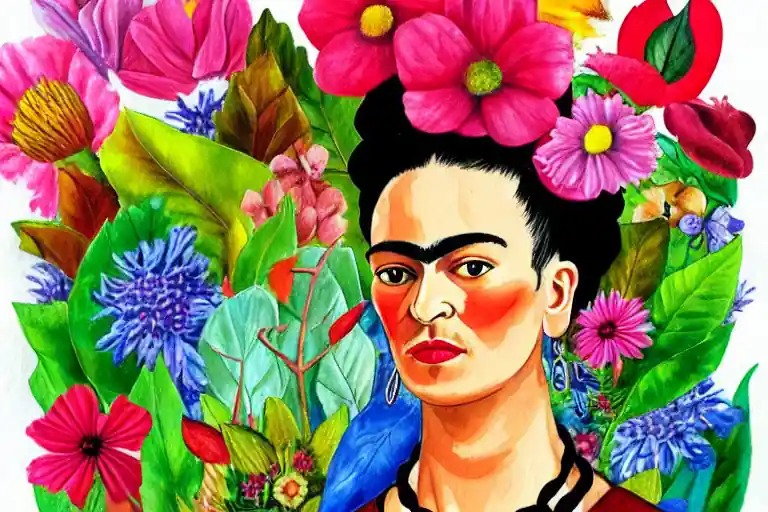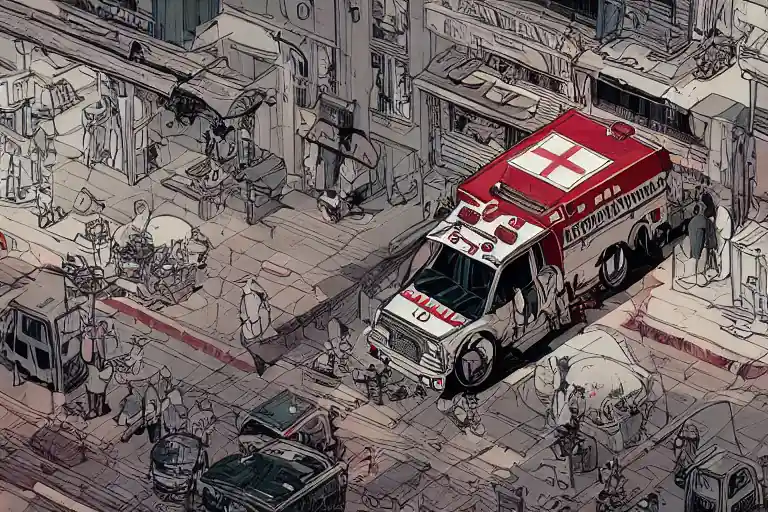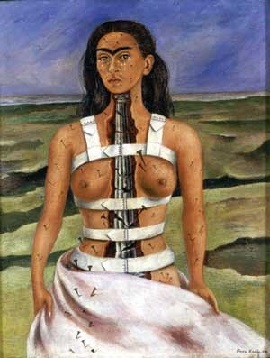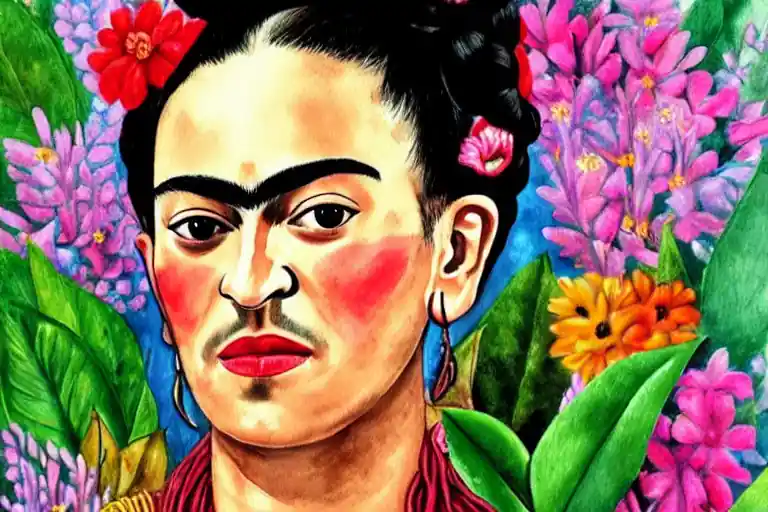Frida Kahlo was a talented artist whose work often focused on questions of self-identity. She suffered greatly with health problems and one theme Kahlo explored was her own experience with chronic pain. But was Frida Kahlo amputated? And why did this happen?
Frida Kahlo had a leg amputated in 1953. The procedure was required due to a combination of lifelong health issues as well as the effects of a bus accident that happened when Kahlo was eighteen years old.
The amputation had a severely detrimental impact on Kahlo’s life and her health, both physically and mentally. Read on to learn more about why Frida Kahlo had an amputation and how the artist explored her health issues in her artwork.
The Amputation Story and Background
Table of Contents
Frida Kahlo’s amputation was the culmination of the artist’s lifelong struggles with her health. Firstly, Kahlo developed polio at the age of six years old which caused her right leg to grow shorter and thinner than her left leg; it also caused a chronic reduction in circulation to the limb.

Furthermore, a freak accident when she was eighteen years old would change her life forever. On the bus home from school one day in 1925, the driver tried to pass an electric streetcar; the two vehicles collided and several people in the bus were killed.
Shockingly, Kahlo was impaled with an iron handrail through her pelvis which fractured the pelvic bone and her injuries were extensive. She punctured her midriff, dislocated her shoulder, broke her spine in three places and her right leg in 11 places.
The young Kahlo spent almost a month in hospital and was restricted to her bed at home for several months. The accident caused injuries and chronic pain that would last for her entire life, especially in her right leg, and ended her dream of becoming a physician. [1]
Want to know more about Frida’s Bus Accident? Check out my deep dive into the events that contributed to Frida’s amputation.
‘The crash bounced us forward and a handrail went right through me, the way a sword pierces a bull.’
Frida Kahlo [2]
The amputation of Kahlo’s right leg occurred in 1953, the same year she held her first solo exhibition in Mexico. By this point in her life, her chronic health issues were so severe that she arrived at the exhibition in an ambulance.
She experienced constant issues with her spine, toes, and feet, suffering from recurring infections and pain. In 1953 gangrene set into her right foot; combined with the poor circulation caused by her childhood polio, her lower leg was past saving. Doctors therefore decided that an amputation at the knee was the best course of action for Kahlo.
The artist was fitted with a prosthetic leg but never fully adjusted to life with an amputated limb. Her mental state suffered severely and Kahlo died around a year later.

Why Was Frida Kahlo’s Leg Amputated?
- Frida Kahlo’s childhood polio had a lasting impact on her leg, resulting in a lack of circulation to the limb. The disease was a formative experience for Kahlo; she later made two paintings of an imaginary friend she had at the time who was active and could dance
- Kahlo repeatedly experienced trophic ulcers on her leg. These were extremely painful and became infected easily, meaning her right leg was permanently weakened
- The bus accident that occurred when Kahlo was 18 years old was catastrophic and lead to chronic issues in her spine, legs, and feet
- Kahlo’s right leg was amputated around a year before she died. Deeply depressed by her chronic health issues, the amputation is thought to have been a large contributing factor to the artist’s death
- After the operation, Kahlo was fitted with a prosthetic leg. She decorated the prosthetic in a beautiful red and green painted design to fit in with her vivid and colorful outfits [3]
How Did Amputation Affect Frida’s Life?
The amputation of Frida Kahlo’s right leg was an extremely distressing event in the artist’s life. Many believe that it accelerated Kahlo’s deterioration – she died a year later in 1954. Sadly, the talented painter was no stranger to pain and in fact her chronic pain informed much of her artwork.
Want to know more about Frida’s death and aftermath? Read my post about how Frida Kahlo died.
Due to Kahlo’s childhood polio and bus accident, the artist had to undergo over 30 surgeries during her life, meaning that pain became an almost constant companion to Frida.
Kahlo used her paintings as an outlet to explore and express her experiences with chronic pain. Her self-portraits in the Surrealist style in particular often attempted to detail how her health issues and pain made her feel.
For instance, Kahlo’s 1944 painting The Broken Column clearly demonstrates her anguish at her health struggles, in particular with the corset she was required to wear to help with her back and spine injuries.

In Surrealist and almost horror-like fashion, Kahlo paints a cracked and crumbling column instead of her spine, with nails piercing her skin. Although clearly in pain, her body is upright, resolute and her face defiant, demonstrating her constant and steadfast perseverance. [4]
Want to know the intricate details of Frida Kahlo’s art style? Read my complete style guide on Frida Kahlo’s works.
Kahlo also detailed her struggles in a diary. After her amputation, she wrote:
‘They amputated my leg six months ago, they have given me centuries of torture and at moments I almost lost my reason. I keep on wanting to kill myself… never in my life have I suffered more’
Frida Kahlo [5]
Following the bus accident when Kahlo was younger, her mother arranged a special easel to be made for the young artist so she could paint while lying down.
Furthermore, a mirror was placed above the easel so she was able to see herself for her self-portraits. [6]
A number of self-portraits by Kahlo feature the artist lying down, many of which also depict her experiences with pain.
After Kahlo’s amputation, her health declined quite rapidly. She only made a few more paintings after the operation, highlighting the detrimental impact the amputation had on the artist’s mental wellbeing.
Frida’s last painting is called Viva La Vida: Watermelons and is rich with symbolism about her life and death. If you want to know all the details check out my post about the painting.

Frequently Asked Questions (FAQs)
Frida Kahlo was frequently in bed because of her extensive health issues. She suffered from spine, leg, and back issues as a result of childhood polio and a bus accident in her youth. Kahlo had over 30 operations in her life, so she often went through long periods of bed rest.
The most traumatic event that caused Frida Kahlo pain was the bus accident she was involved in when she was 18 years old. Kahlo also experienced multiple miscarriages which caused intense physical pain and mental anguish.
Get Notified When We Publish Similar Articles
References
- Maranzani, Barbara. “How a Horrific Bus Accident Changed Frida Kahlo’s Life.” Biography.com, Accessed 12 Dec. 2022, https://www.biography.com/news/frida-kahlo-bus-accident.
- Kahlo, Frida. “The accident.” Museo Dolores Olmedo, Google Arts and Culture, 17 Sep 1926. Accessed 12 Dec. 2022. https://artsandculture.google.com/story/the-accident-museo-dolores-olmedo/-gURFngvDrTJIw?hl=en.
- Laneri, Raquel. “Even Frida Kahlo’s Prosthetic Leg Is a Fabulous Work of Art.” New York Post, 9 Feb. 2019. Accessed 12 Dec. 2022. https://nypost.com/2019/02/08/even-frida-kahlos-prosthetic-leg-is-a-fabulous-work-of-art/.
- The Broken Column by Frida Kahlo, https://www.kahlo.org/broken-column/.
- Zamora, Martha. The Brush of Anguish, p. 130. Chronicle Books, 1990.
- “Frida Kahlo Biography in Details.” https://www.frida-kahlo-foundation.org/biography.html.
